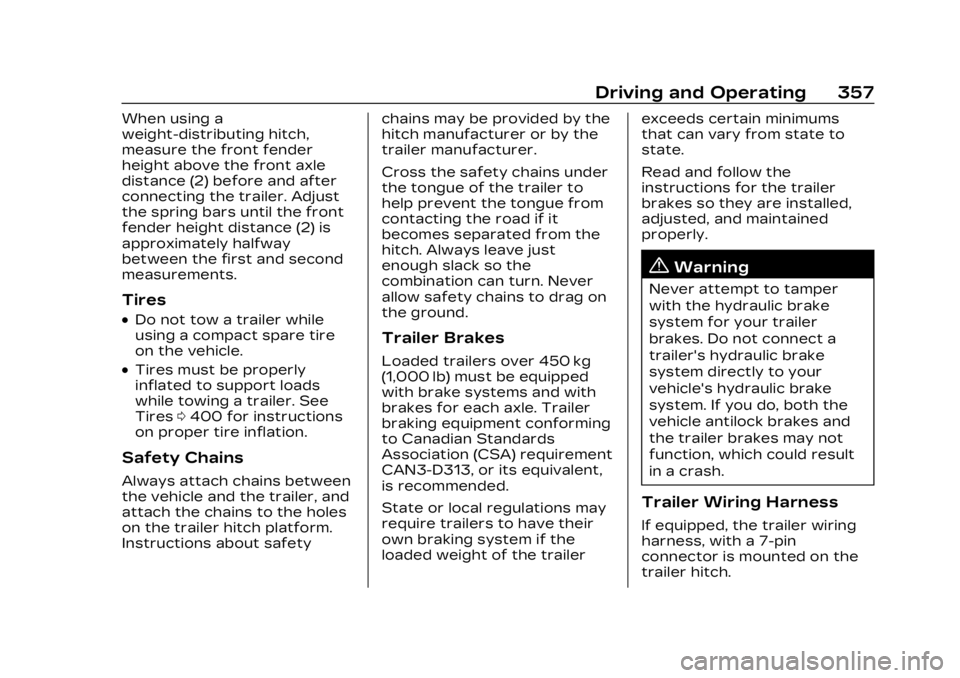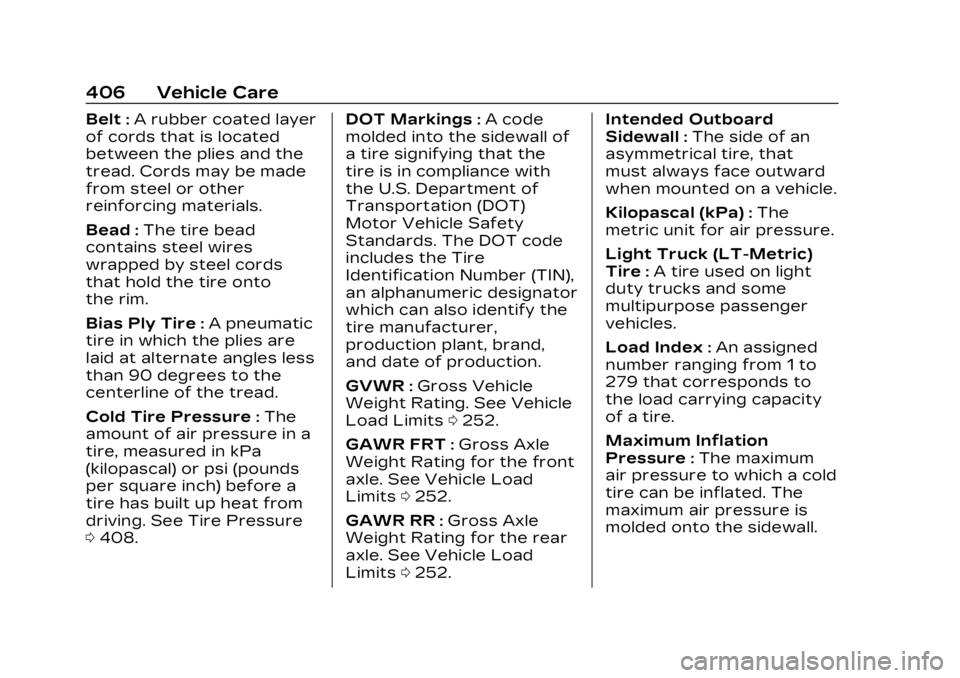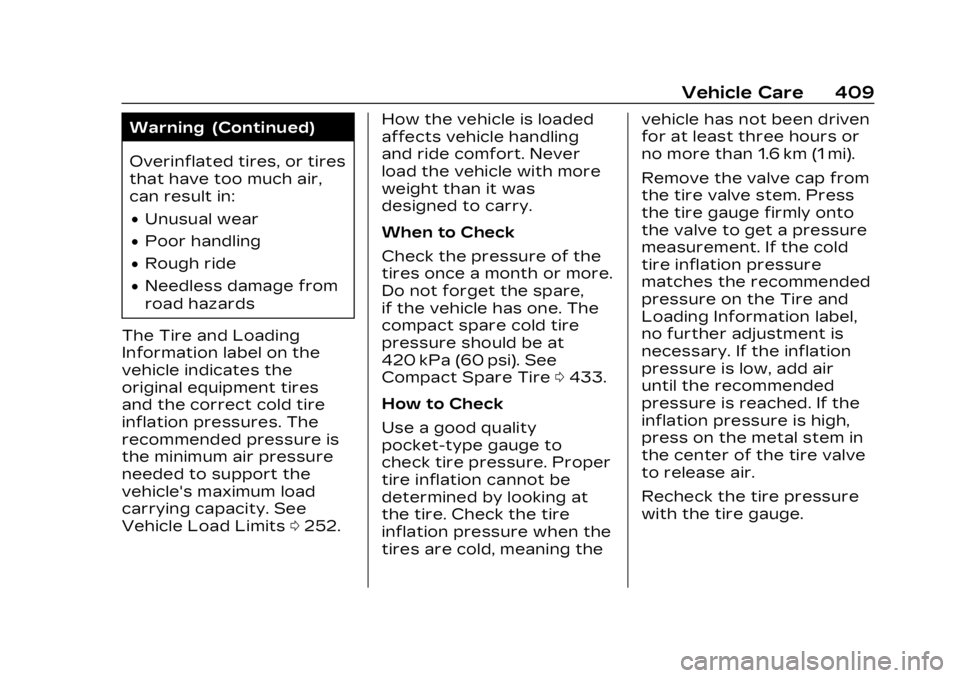weight CADILLAC XT6 2023 Owner's Manual
[x] Cancel search | Manufacturer: CADILLAC, Model Year: 2023, Model line: XT6, Model: CADILLAC XT6 2023Pages: 507, PDF Size: 6.49 MB
Page 358 of 507

Cadillac XT6 Owner Manual (GMNA-Localizing-U.S./Canada-16405819) -
2023 - CRC - 3/22/22
Driving and Operating 357
When using a
weight-distributing hitch,
measure the front fender
height above the front axle
distance (2) before and after
connecting the trailer. Adjust
the spring bars until the front
fender height distance (2) is
approximately halfway
between the first and second
measurements.
Tires
.Do not tow a trailer while
using a compact spare tire
on the vehicle.
.Tires must be properly
inflated to support loads
while towing a trailer. See
Tires0400 for instructions
on proper tire inflation.
Safety Chains
Always attach chains between
the vehicle and the trailer, and
attach the chains to the holes
on the trailer hitch platform.
Instructions about safety chains may be provided by the
hitch manufacturer or by the
trailer manufacturer.
Cross the safety chains under
the tongue of the trailer to
help prevent the tongue from
contacting the road if it
becomes separated from the
hitch. Always leave just
enough slack so the
combination can turn. Never
allow safety chains to drag on
the ground.
Trailer Brakes
Loaded trailers over 450 kg
(1,000 lb) must be equipped
with brake systems and with
brakes for each axle. Trailer
braking equipment conforming
to Canadian Standards
Association (CSA) requirement
CAN3-D313, or its equivalent,
is recommended.
State or local regulations may
require trailers to have their
own braking system if the
loaded weight of the trailerexceeds certain minimums
that can vary from state to
state.
Read and follow the
instructions for the trailer
brakes so they are installed,
adjusted, and maintained
properly.
{Warning
Never attempt to tamper
with the hydraulic brake
system for your trailer
brakes. Do not connect a
trailer's hydraulic brake
system directly to your
vehicle's hydraulic brake
system. If you do, both the
vehicle antilock brakes and
the trailer brakes may not
function, which could result
in a crash.
Trailer Wiring Harness
lf equipped, the trailer wiring
harness, with a 7-pin
connector is mounted on the
trailer hitch.
Page 361 of 507

Cadillac XT6 Owner Manual (GMNA-Localizing-U.S./Canada-16405819) -
2023 - CRC - 3/22/22
360 Driving and Operating
Warning (Continued)
improperly or overloaded
trailer, unrestrained cargo,
improper trailer hitch
configuration, or improperly
inflated or incorrect vehicle
or trailer tires. See Towing
Equipment0356 for trailer
ratings and hitch setup
recommendations.
Trailer Tires
Special Trailer (ST) tires differ
from vehicle tires. Trailer tires
are designed with stiff
sidewalls to help prevent sway
and to support heavy loads.
These features can make it
difficult to determine if the
trailer tire pressures are low
only based on a visual
inspection.
Always check all trailer tire
pressures before each trip
when the tires are cool. Low
trailer tire pressure is a
leading cause of trailer tire
blowouts. Trailer tires deteriorate over
time. The trailer tire sidewall
will show the week and year
the tire was manufactured.
Many trailer tire
manufacturers recommend
replacing tires more than six
years old.
Overloading is another leading
cause of trailer tire blowouts.
Never load the trailer with
more weight than the tires are
designed to support. The load
rating is on the trailer tire
sidewall.
Always know the maximum
speed rating for the trailer
tires before driving. This may
be significantly lower than the
vehicle tire speed rating. The
speed rating may be on the
trailer tire sidewall. If the
speed rating is not shown, the
default trailer tire speed rating
is 105 km/h (65 mph).
Conversions and
Add-Ons
Add-On Electrical
Equipment
{Warning
The Data Link Connector
(DLC) is used for vehicle
service and Emission
Inspection/Maintenance
testing. See Malfunction
Indicator Lamp (Check
Engine Light)
0134. A device
connected to the DLC —
such as an aftermarket fleet
or driver-behavior tracking
device —may interfere with
vehicle systems. This could
affect vehicle operation and
cause a crash. Such devices
may also access information
stored in the vehicle’s
systems.
Page 407 of 507

Cadillac XT6 Owner Manual (GMNA-Localizing-U.S./Canada-16405819) -
2023 - CRC - 3/22/22
406 Vehicle Care
Belt:A rubber coated layer
of cords that is located
between the plies and the
tread. Cords may be made
from steel or other
reinforcing materials.
Bead
:The tire bead
contains steel wires
wrapped by steel cords
that hold the tire onto
the rim.
Bias Ply Tire
:A pneumatic
tire in which the plies are
laid at alternate angles less
than 90 degrees to the
centerline of the tread.
Cold Tire Pressure
:The
amount of air pressure in a
tire, measured in kPa
(kilopascal) or psi (pounds
per square inch) before a
tire has built up heat from
driving. See Tire Pressure
0 408. DOT Markings
:A code
molded into the sidewall of
a tire signifying that the
tire is in compliance with
the U.S. Department of
Transportation (DOT)
Motor Vehicle Safety
Standards. The DOT code
includes the Tire
Identification Number (TIN),
an alphanumeric designator
which can also identify the
tire manufacturer,
production plant, brand,
and date of production.
GVWR
:Gross Vehicle
Weight Rating. See Vehicle
Load Limits 0252.
GAWR FRT
:Gross Axle
Weight Rating for the front
axle. See Vehicle Load
Limits 0252.
GAWR RR
:Gross Axle
Weight Rating for the rear
axle. See Vehicle Load
Limits 0252. Intended Outboard
Sidewall
:The side of an
asymmetrical tire, that
must always face outward
when mounted on a vehicle.
Kilopascal (kPa)
:The
metric unit for air pressure.
Light Truck (LT-Metric)
Tire
:A tire used on light
duty trucks and some
multipurpose passenger
vehicles.
Load Index
:An assigned
number ranging from 1 to
279 that corresponds to
the load carrying capacity
of a tire.
Maximum Inflation
Pressure
:The maximum
air pressure to which a cold
tire can be inflated. The
maximum air pressure is
molded onto the sidewall.
Page 409 of 507

Cadillac XT6 Owner Manual (GMNA-Localizing-U.S./Canada-16405819) -
2023 - CRC - 3/22/22
408 Vehicle Care
UTQGS (Uniform Tire
Quality Grading
Standards)
:A tire
information system that
provides consumers with
ratings for a tire's traction,
temperature, and
treadwear. Ratings are
determined by tire
manufacturers using
government testing
procedures. The ratings
are molded into the
sidewall of the tire. See
Uniform Tire Quality
Grading 0421.
Vehicle Capacity Weight
:
The number of designated
seating positions multiplied
by 68 kg (150 lbs) plus the
rated cargo load. See
Vehicle Load Limits 0252. Vehicle Maximum Load on
the Tire
:Load on an
individual tire due to curb
weight, accessory weight,
occupant weight, and cargo
weight.
Vehicle Placard
:A label
permanently attached to a
vehicle showing the
vehicle's capacity weight
and the original equipment
tire size and recommended
inflation pressure. See “Tire
and Loading Information
Label” under Vehicle Load
Limits 0252.
Tire Pressure
Tires need the correct
amount of air pressure to
operate effectively.
{Warning
Neither tire underinflation
nor overinflation is good.
Underinflated tires,
or tires that do not have
enough air, can result in:
.Tire overloading and
overheating, which
could lead to a blowout
.Premature or
irregular wear
.Poor handling
.Reduced fuel economy
for internal combustion
engine vehicles
.Reduced range for
electric vehicles
(Continued)
Page 410 of 507

Cadillac XT6 Owner Manual (GMNA-Localizing-U.S./Canada-16405819) -
2023 - CRC - 3/22/22
Vehicle Care 409
Warning (Continued)
Overinflated tires, or tires
that have too much air,
can result in:
.Unusual wear
.Poor handling
.Rough ride
.Needless damage from
road hazards
The Tire and Loading
Information label on the
vehicle indicates the
original equipment tires
and the correct cold tire
inflation pressures. The
recommended pressure is
the minimum air pressure
needed to support the
vehicle's maximum load
carrying capacity. See
Vehicle Load Limits 0252. How the vehicle is loaded
affects vehicle handling
and ride comfort. Never
load the vehicle with more
weight than it was
designed to carry.
When to Check
Check the pressure of the
tires once a month or more.
Do not forget the spare,
if the vehicle has one. The
compact spare cold tire
pressure should be at
420 kPa (60 psi). See
Compact Spare Tire
0433.
How to Check
Use a good quality
pocket-type gauge to
check tire pressure. Proper
tire inflation cannot be
determined by looking at
the tire. Check the tire
inflation pressure when the
tires are cold, meaning the vehicle has not been driven
for at least three hours or
no more than 1.6 km (1 mi).
Remove the valve cap from
the tire valve stem. Press
the tire gauge firmly onto
the valve to get a pressure
measurement. If the cold
tire inflation pressure
matches the recommended
pressure on the Tire and
Loading Information label,
no further adjustment is
necessary. If the inflation
pressure is low, add air
until the recommended
pressure is reached. If the
inflation pressure is high,
press on the metal stem in
the center of the tire valve
to release air.
Recheck the tire pressure
with the tire gauge.
Page 420 of 507

Cadillac XT6 Owner Manual (GMNA-Localizing-U.S./Canada-16405819) -
2023 - CRC - 3/22/22
Vehicle Care 419
GM recommends that tires,
including the spare if
equipped, be replaced after six
years, regardless of tread
wear. To identify the age of a
tire, use the tire manufacture
date, which is the last four
digits of the DOT Tire
Identification Number (TIN)
molded into one side of the
tire sidewall. The last four
digits of the TIN indicate the
tire manufactured date. The
first two digits represent the
week and the last two digits,
the year. For example, the
third week of the year 2020
would have a 4-digit DOT date
of 0320. Week 01 is the first
full week (Sunday through
Saturday) of each year.
Vehicle Storage
Tires age when stored
normally mounted on a parked
vehicle. Park a vehicle that will
be stored for at least a month
in a cool, dry, clean area away
from direct sunlight to slow
aging. This area should be freeof grease, gasoline, or other
substances that can
deteriorate rubber.
Parking for an extended
period can cause flat spots on
the tires that may result in
vibrations while driving. When
storing a vehicle for at least a
month, remove the tires or
raise the vehicle to reduce the
weight from the tires.
Buying New Tires
GM has developed and
matched specific tires for
the vehicle. The original
equipment tires installed
were designed to meet
General Motors Tire
Performance Criteria
Specification (TPC Spec)
system rating. When
replacement tires are
needed, GM strongly
recommends buying tires
with the same TPC Spec
rating.
GM's exclusive TPC Spec
system considers over a
dozen critical specifications
that impact the overall
performance of the vehicle,
including brake system
performance, ride and
handling, traction control,
and tire pressure
monitoring performance.
GM's TPC Spec number is
molded onto the tire's
sidewall near the tire size.
If the tires have an
all-season tread design, the
TPC Spec number will be
followed by MS for mud
and snow. See Tire
Sidewall Labeling
0402 for
additional information.
GM recommends replacing
worn tires in complete sets
of four. Uniform tread
depth on all tires will help
to maintain the
performance of the vehicle.
Braking and handling
Page 426 of 507

Cadillac XT6 Owner Manual (GMNA-Localizing-U.S./Canada-16405819) -
2023 - CRC - 3/22/22
Vehicle Care 425
If a Tire Goes Flat
It is unusual for a tire to blow
out while driving, especially if
the tires are maintained
properly. See Tires0400. If air
goes out of a tire, it is much
more likely to leak out slowly.
But if there is ever a blowout,
here are a few tips about what
to expect and what to do:
If a front tire fails, the flat tire
creates a drag that pulls the
vehicle toward that side. Take
your foot off the accelerator
pedal and grip the steering
wheel firmly. Steer to maintain
lane position, and then gently
brake to a stop, well off the
road, if possible.
A rear blowout, particularly on
a curve, acts much like a skid
and may require the same
correction as used in a skid.
Stop pressing the accelerator
pedal and steer to straighten
the vehicle. It may be very
bumpy and noisy. Gently brake
to a stop, well off the road,
if possible.{Warning
Driving on a flat tire will
cause permanent damage to
the tire. Re-inflating a tire
after it has been driven on
while severely underinflated
or flat may cause a blowout
and a serious crash. Never
attempt to re-inflate a tire
that has been driven on
while severely underinflated
or flat. Have your dealer or
an authorized tire service
center repair or replace the
flat tire as soon as possible.
{Warning
Lifting a vehicle and getting
under it to do maintenance
or repairs is dangerous
without the appropriate
safety equipment and
training. If a jack is provided
with the vehicle, it is
designed only for changing a
(Continued)
Warning (Continued)
flat tire. If it is used for
anything else, you or others
could be badly injured or
killed if the vehicle slips off
the jack. If a jack is provided
with the vehicle, only use it
for changing a flat tire.
If a tire goes flat, avoid further
tire and wheel damage by
driving slowly to a level place,
well off the road, if possible.
Turn on the hazard warning
flashers. See Hazard Warning
Flashers 0160.
If your vehicle is loaded at or
near maximum cargo capacity,
it may be difficult to fit the jack
under the vehicle due to the
environment (shoulder slope,
road debris, etc.). Removal of
some weight may improve the
ability to fit the jack under the
vehicle at the correct jacking
location.